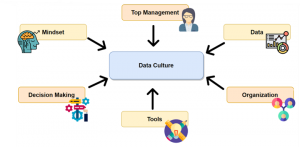
In the last few years, many companies have already adopted or have begun to approach various Analytics solutions, which allows to gain insights for operational, strategic, and tactical decisions, aiming to have a crucial advantage on their competitors. Infrastructures as Data Warehouses and Data Lakes allow to exploit a company’s data assets, making them accessible to both Business Analysts and Data Scientists to create Predictive Analytics models and other analysis and visualization tools. In such context corporate culture hugely influences the effectiveness of Business Intelligence and Artificial Intelligence solutions.
Developing an innovation-promoting corporate culture means building an environment in which each employee feels free to express their opinion and have a comfortable degree of autonomy in their tasks, so that they can take alternative paths in solving daily issues. In this case, a data-driven culture is characterized by a decision-making process that emphasizes the possibility of experimenting new solutions (acknowledging the fact that they could fail) as long as they are led by data and not by opinions or feelings. It is important to remember that in an innovation culture, failure is to be considered useful as well, whenever it teaches something, and the risks are reasonably limited. Another crucial element is the possibility of coming up with new ideas and new points of view, questioning already established aspects and processes. In an innovation-focused culture, the sentence “we have always done it this way” should not be longer invalidate new ideas, regardless of their great potential if taken into consideration.
Let’s see what the most critical ingredients for a data-driven business culture are:
Sommario
Top Management
Top Management has, without any doubt, a key role in adopting a data-driven culture and it must be actively involved in strategy development processes for the introduction of the appropriate changes, without disrupting the company dynamics. On one hand, in fact, middle management and employees could be unfriendly to the shift, opposing the adoption of new tools and generating potential conflicts with new professional, such as Data Scientists. On the other hand, however, exaggerated expectations on Analytics solutions’ effectiveness could nurture a feeling of distrust whether desired results are not immediately achieved (it is essential to keep in mind that some tools show their effectiveness in the long run).
Data
This concept may seem obvious, but data are the key elements of each data-driven strategy. In this regard, it is necessary to understand which data the company owns and from which source they are produced, as well as ensure to have taken appropriate action to preserve high quality data, so that they reflect the objective reality. This applies, not only to companies approaching this perspective for the first time, but also to companies that already have invested in Business Intelligence and Data Analytics in the past. Historical data can always be integrated with new sources, both internal and external, and analysed through new tools.
Tools
Each company aiming to focus their culture on data usage should equip itself with the most appropriate tools to suit its needs and goals. A company of modest dimensions, with a limited amount of data, can simply adopt visualization tools, such as Power Bi, Tableau or Qlik for implementing the so-called self-service Business Intelligence. Bigger companies, owning a bigger volume of data and having broader and more diverse demands, should opt for tools as Data Warehouse and Data Lakes, ETL tools and OLAP cubes, for creating a properly effective architecture. In case a solid front-end architecture is missing, many issues can occur, such as IT department (in charge of finding data) overloads and data inconsistency, that can potentially present conflicting versions of facts, undermining the validity of Business Intelligence. Lastly, whenever the company already owns a solid BI and want to increase its Analytics potential, it is necessary to adopt the best Predictive Analytics and Data Mining tools and use them with the appropriate skills for producing tangible results (in such case it is appropriate to enlist a team with an internal Data Scientist or external advisors and expertise).
Organization
Most companies already own, within the IT department, staff dedicated to keep the Business Intelligence infrastructure active. Typically, BI employees take care of data extraction for creating standardized reports, on a monthly or quarterly bases, presented by business analysts. For incrementing Analytics capacity, however, experimenting is necessary. In this sense, with a view towards broadening analysis spectrum, it is vital to provide data to analysts and management, so that they can autonomously test their ideas, without overloading IT department. Such “democratization” process data access should however be paired with ongoing training, so that data users can take full advantage of their potential.
Decision-making
Once the company holds the above-mentioned ingredients, decision-making is the field where the new data-driven culture will be seen. There will be a renewed decisional process, where the “test and learn” paradigm will be the standard. Some of the experiment will inevitably fail and in that case it necessary not to be disheartened, but to learn from previous mistakes. In a data-driven corporate culture there are not too much unusual or quirky ideas, provided that they come from a legitimate data analysis. In an ideal setting, for any business issue data to be collected and analysed for finding the best solution are determined, so that decisions are made without relying decisions on opinions or feelings.
Mindset
Finally, the least tangible but most important ingredient is embracing changes. Modifying the corporate culture is not an easy task and, even with all the right tools, the outcome is by no means certain, and people could not adapt their mindset to a data-centered approach. It is crucial for the company staff to understand how a data-driven culture can affect performance and positively transform daily tasks, improving corporate life and, possibly, increasing employees’ salaries and benefits.
Sources:
Vidgen, R., Shaw, S., & Grant, D. B. (2017). Management challenges in creating value from business
analytics. European Journal of Operational Research.
LaValle et al. (2011). Big Data, Analytics and the Path from Insights to Value. MIT Sloan Management Review.
Rezzani, A. (2012). Business Intelligence: processi, metodi, utilizzo in azienda. Maggioli editore.
Comments are closed.








